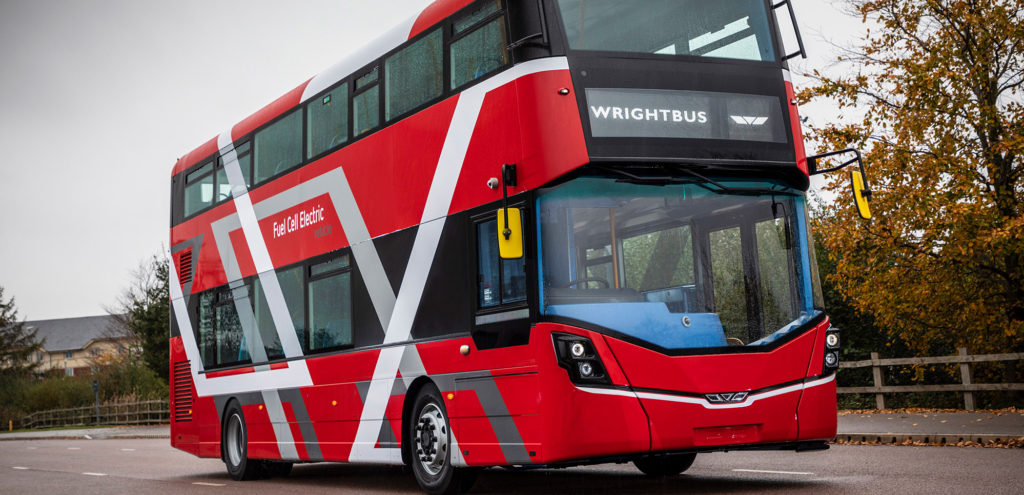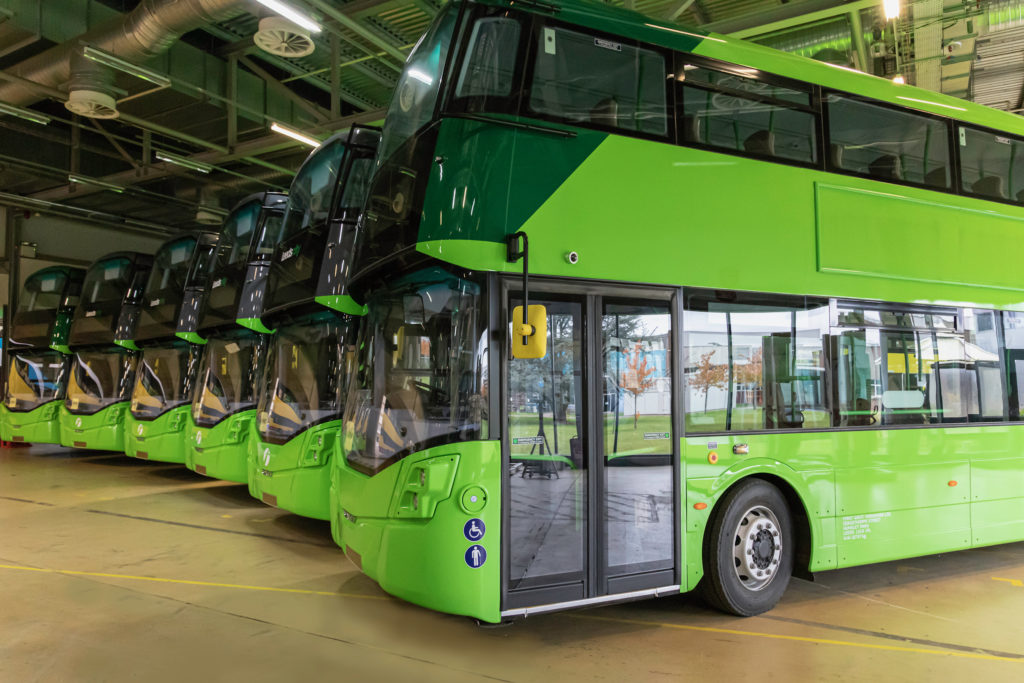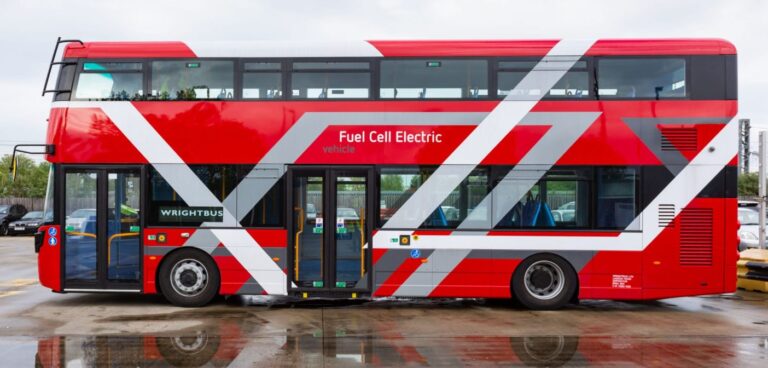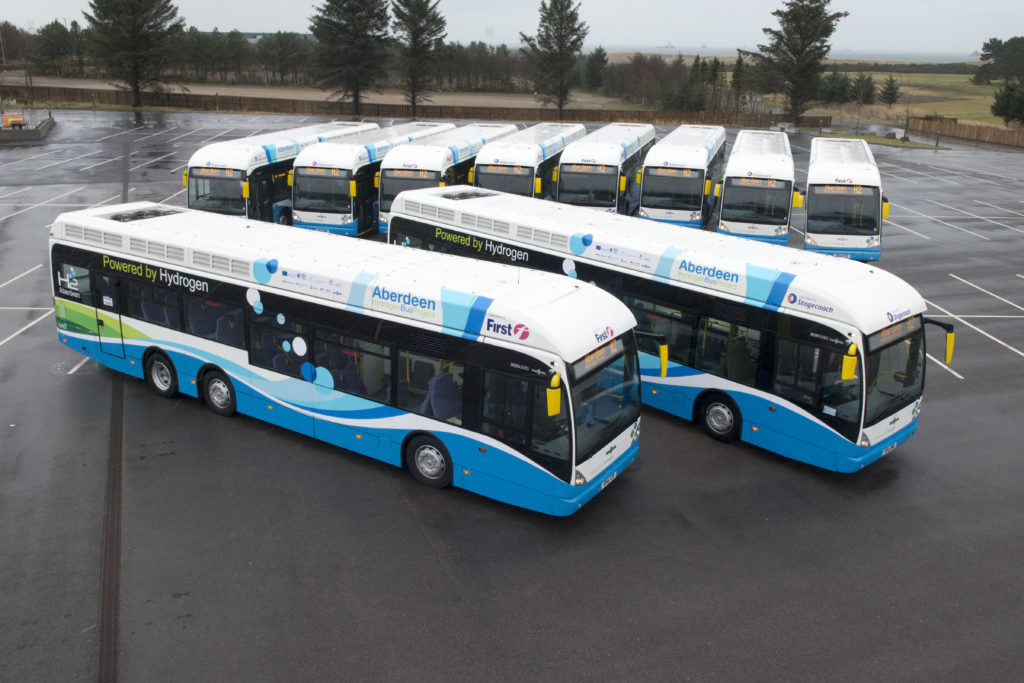Jo Bamford, grandson of JCB founder Joseph Bamford, discusses his plans to bring 3,000 UK-built hydrogen-powered buses to towns and cities across the country by 2024. Alisdair Suttie reports…
“Economies of scare are vital to the success of hydrogen as a vehicle fuel in the UK.” This is the blunt assessment of Jo Bamford, who heads hydrogen production company Ryse and wants to see 3,000 buses powered by this fuel on UK roads by 2024.
Bamford is equally straight-talking when it comes to explaining his plan to achieve this goal. He says: “We need to de-carbonise our public transport and heavy vehicles quickly to avoid the continuing reliance on diesel and ongoing pollution that comes with this. Hydrogen works well on a large scale because it can be produced locally rather than being transported from large refineries to where it’s needed.
“This is why buses are an ideal starting point for the roll-out of a hydrogen- based transport plan in the UK and in many other countries. With buses, they stick to the same routes and work from a central depot, which makes it simple to plan their fuelling requirements.

“Another advantage of hydrogen is you fill up the vehicle’s tank in very much the same way you do with existing fossil fuels, so there are no demands for the operator to change their existing routines.”
As part of this cultural similarity, Bamford also points to the time it takes for a bus to be filled with hydrogen: “It takes only seven minutes to completely fill a bus’ hydrogen tank, which is about the same as it takes with diesel. Once fuelled, the hydrogen bus has the same range as a diesel one and just about the only discernible difference is our buses have a smaller back window due to the positioning of the hydrogen fuel cell that produces the electricity.”
Great expectations
When Bamford says “our buses”, he really means it too because not only is he executive chairman of Ryse, he also owns Wrightbus, the Northern Ireland- based bus manufacturer. He bought the firm out of administration late in 2019 and sees an opportunity to expand its workforce to around 1,000 people by 2024 if his plan for hydrogen buses is rolled out.
This scale of production is nothing new to Bamford, who is heir to the JCB empire that produces machinery for the construction, agriculture and military industries. At present, Wrightbus has already supplied hydrogen-powered buses to Transport for London and has an order for 20 from operators in Aberdeen
The Scottish city has run a trial of hydrogen-powered buses and found them to work very well. Bamford sees this as a prime example for the rest of the UK to follow: “Twenty buses in Aberdeen is 10% of the city’s total bus fleet. It is entirely realistic to believe the entire fleet can be replaced with hydrogen buses over the coming few years to make it completely zero emissions. After all, hydrogen produces nothing but clean water when it’s used in a fuel cell to make electricity.”

Applying this arithmetic to the whole of the UK is why Bamford reckons 3,000 hydrogen buses by 2024 is achievable: “There are around 30,000 buses on the roads in the UK right now, so replacing only 10% of them over a five-year period seems like a very good starting point.
“In Scotland, we are encouraging the government to develop an all-hydrogen plan for buses and also for trains. As with other heavy vehicles, rail is ideally suited to hydrogen power, especially in Scotland where there is a much greater reliance at the moment on diesel power.”
Seize the initiative
A key part of Bamford’s plan is to roll out green hydrogen production facilities around the UK. Ryse has one in build at the moment in Kent that uses an offshore windfarm to produce low-cost renewable electricity to create the hydrogen. Four more are planned to be in use by 2025 and will be built in economically deprived areas where green industry jobs will be welcome.
“The UK has missed the boat with leading the world in vehicle battery technology,” says Bamford. “So, this is a chance to put the country at the forefront of hydrogen technology and export our knowledge.
“This must start now if we want to seize the initiative. Buses are the starting point, but we can apply the same technology to other heavy vehicles such as trucks, vans, rail and ships.”
LIBERATING HEAVY TRANSPORT
Jo Bamford may be the heir to the JCB firm, but his focus is on the green hydrogen production company Ryse that he founded and heads up. The company was set up in 2017 to deliver affordable hydrogen as a fuel to the heavy transport industry, with buses as the first step in that process.The environmental reasons for starting Ryse are understandable as transport in the UK reportedly accounts for 27% of the country’s emissions. However, Bamford is no eco-warrior and is sanguine about his reasons for starting the business: “I saw a viable opportunity that could free the heavy transport industry from a reliance on diesel within a decade. My aim is to see all buses in the UK running on hydrogen by 2030.”
Bamford is equally tough in his assessment of battery-electric vehicles: “Electric cars have helped pave the way for electric power, but there are too many limitations on range and charging times for it to be practical in the heavy transport sector.
“I also think hydrogen is the future for cars, but we need to focus on the heavy vehicle side at present as this is the quickest and easiest route to decarbonising these vehicles. It also comes with minimal disruption to our streets, cities, the power grid and end users as we can supply hydrogen in the same way most drivers are used to filling up with petrol or diesel.’
Confident as Bamford is about the future for hydrogen, he still wants government financial assistance to help put hydrogen buses on an equal cost footing with diesel.
He says: “We have an electric car grant at present, so why not an electric bus grant? Three thousand hydrogen buses would slash carbon dioxide emissions by 238,000 tonnes per year, which is equivalent to removing some 107,000 cars from the UK’s roads.

“Apply that to the whole bus industry and the savings are significant, but if it were rolled out to every heavy vehicle, it’s enormous.
“This is why we have submitted proposals to the UK government already for £500m to be set aside for the hydrogen industry. This is 10% of the National Bus Strategy fund and £200m of this would be to build energy production facilities and deliver the fuel using zero emissions transport. The rest would subsidise operators to choose a hydrogen bus at the same price as a diesel.”
This is why Bamford believes economies of scale are so important for the future of hydrogen buses. “The more we can build, the cheaper they become for operators to buy and the quicker we will see the benefits in reduced emissions. Also, the more hydrogen vehicles we have on our roads, the larger the infrastructure will be to support them rather than the very small system we have now.
“With ready access to renewable energy to produce low-cost hydrogen, the UK is almost uniquely placed to lead the world and prevent us from going back to our old habits. We’ve seen in the recent pandemic how quickly emissions can drop when fossil-fuelled vehicles are not on the road. This shows how vital it is to move to hydrogen as the fuel for public transport and heavy vehicles.”
EARLY ADOPTER
Aberdeen has been at the vanguard of the UK’s hydrogen movement for some time. The UK’s first hydrogen production and bus refuelling station opened in the Scottish city in 2015, as part of a £19m green transport demonstration project.Led by Aberdeen City Council, the H2 Aberdeen programme tested the economic and environmental benefits of hydrogen transport technologies with the aim of driving the development of hydrogen technologies.
A total of 10 single-deck buses were operated by First Aberdeen and Stagecoach over the course of the scheme, which was launched in a bid to reduce the city’s carbon footprint.
Now, some of the world’s first hydrogen-powered double decker buses are expected to enter service in Aberdeen this summer. Some 20 hydrogen buses have been produced by Wrightbus in Northern Ireland and operator First Aberdeen is to run the buses along two of its most popular service routes.
The hydrogen double deckers arrived in the spring for a period of final testing along with training for drivers. The £8.3m project has been funded by Aberdeen City Council, the Scottish government, and the EU’s Fuel Cells and Hydrogen Joint Undertaking public private partnership, with an investment of about £500,000 per vehicle.
The buses, which emit only water, are reportedly as efficient as electric equivalents, with refuelling taking less than 10 minutes and offering a greater range.
David Phillips, operations director for First Aberdeen, says: “We are in the process of adapting our depot to accommodate these environmentally friendly zero-emission vehicles and are upskilling all our staff to accommodate this next generation of buses.
“It is a huge effort from all our staff to deliver this project, so we extremely proud to be helping the city to lead the way on the hydrogen journey.”
According to First, the vehicles will mainly operate on the Service 19 (Peterculter to Tillydrone) and the Service X27 (City Centre to Aberdeen International Airport via Dyce station) routes. The service is being part funded by the European Union’s JIVE (Joint Initiative for hydrogen Vehicles across Europe) project, which aims to aid commercialisation of hydrogen buses through joint procurement between cities.
This article originally appeared in the June 2020 issue of CiTTi Magazine






